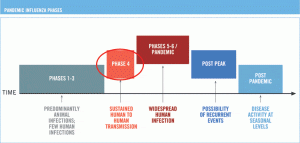

As of Monday, 27 April, the US has reported 40 laboratory confirmed cases of swine influenza H1N1 infection in California, Kansas, New York City, Ohio, and Texas. Mexico has confirmed 26 human cases with seven deaths, Canada reports six cases, and Spain one case. The first two cases of the illness in the UK were reported in Scotland. These statistics were obtained from ProMED-mail, WHO, and CDC.
You might find higher numbers from other sources. The difference is that the numbers in the preceding paragraph are laboratory confirmed cases – meaning that the virus has been isolated from the patient and identified as swine influenza H1N1 (or A/California/07/2009 (H1N1), in the influenza virus nomenclature). Many suspected cases are being reported – in these the disease appears to be influenza, but confirmation of infection with A/California/07/2009 (H1N1) has not been confirmed by laboratory tests. For example, the suspected death toll in Mexico is 149, with 1995 hospitalizations. There are also suspected cases in England and Australia.
As a consequence of the continuing spread of the virus, the WHO Director-General has raised the level of influenza pandemic alert from phase 3 to phase 4. According to WHO, “This phase is characterized by verified human-to-human transmission of an animal or human-animal influenza reassortant virus able to cause community-level outbreaks. A complete explanation of pandemic alert phases can be found at the WHO website. In Mexico, health authorities have closed schools in the entire country until 6 May. In the US, CDC activated its Emergency Operations Center to coordinate the agency’s response, and the Secretary of the Department Homeland Security has declared a public health emergency. These actions will allow the release of funds to support the public health response.
Because a vaccine is not yet available for A/California/07/2009 (H1N1), antiviral compounds (Tamiflu and Relenza) must be used to curb epidemics. The use of such compounds may save many lives at the expense of selecting for drug resistant viruses. If such variants emerge before immunization can be carried out they will limit our ability to control the infection.
Here are my answers to some questions posted to virology blog:
Q: Do you have any theories as to why the mortality rate (apparently) is higher in Mexico than it is elsewhere?
A: I have two theories. One involves the possibility that infection with the current circulating human H1N1 strain might confer some protection, in the form of milder disease, to infection with the swine H1N1 virus. If this is true – and it might not be – then one could speculate that individuals in Mexico City were less immune to human H1N1, and consequently experienced more severe disease when infected with the swine strain.
The other theory is more vague – because Mexico City is extremely densely populated, the virus may spread more quickly, infecting more people, leading to selection of more virulent viral variants.
Q: Are viruses more likely to get more or less pathogenic as time goes on?
A: It could go either way. Viruses need living hosts in which to multiply – if they kill the host quickly, or debilitate the host so it cannot interact with others (to spread the infection), then the virus will not endure. On the other hand, you can imagine how increased virulence leading to more coughing and sneezing could help spread the infection. This topic is hotly argued among virologists, which means that both sides probably are correct.
Q: Should we be saving our Relenza and Tamiflu if this does become highly pathogenic?
A: Save them for the fall, in case the virus returns then. Flu season is basically over in the US, and with the increasing heat and humidity (over 90° today in NYC) virus transmission should soon stop. However, if A/California/07/2009 (H1N1) takes hold in the southern hemisphere in the coming months – their flu season is still beginning – it is likely to return to the northern hemisphere in the fall. Unfortunately, by then extensive antiviral use in the southern hemisphere is likely to have produced drug-resistant variants.
Q: I keep thinking about the Great Influenza book – that in an era with no planes, the virus traveled around the world three times. Given our capacity for travel now, is quarantine even possible?
A: No. The CDC has already said quarantine is futile. Check out the transcripts of their press conferences; they are a good read (or listen).
Q: Will our over vigilance in treating this lead to its becoming resistant quicker?
A: If you mean treating the infection with antivirals, then the answer is a resounding yes. Many people have likely been saving Relenza and Tamiflu, and they will take them at the first sign of a respiratory illness.
Q: Should this be considered a prime candidate for next winters flu season?
A: It depends on what happens in the southern hemisphere. In the next week or two we will know whether A/California/07/2009 (H1N1) spreads in the lower half of the globe and causes epidemics of disease. If it does, then it is highly likely that the virus will return here in the fall. If the virus fails to spread, then everyone can go back to worrying about H5N1.
Send your questions to virology blog (virology@virology.ws) and I will post my answers each day.

Comments are closed.